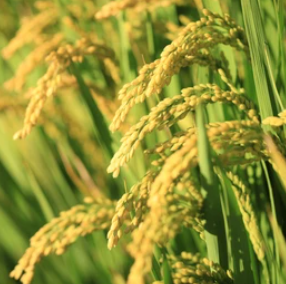Information report for Os11N3;OsSWEET14
Gene Details
|

|
Functional Descriptions
- A knowledge-based molecular screen uncovers a broad spectrum OsSWEET14 resistance allele to bacterial blight from wild rice.
- We show that this allele, which we call xa41(t), confers resistance against half of the tested Xoo strains representative of various geographic origins and genetic lineages, highlighting the selective pressure for the pathogen to accommodate with OsSWEET14 polymorphism and reciprocally the apparent limited possibilities for the host to create variability at this particular S gene.
- In a proof-of-principle experiment, we screened a germplasm of 169 rice accessions for polymorphism in the promoter of the major bacterial blight susceptibility (S) gene OsSWEET14 which encodes a sugar transporter targeted by numerous strains of X.
- Surprisingly, although indels within TalC EBE prevented OsSWEET14 induction in response to BAI3 wild-type bacteria relying on TalC, loss of TalC-responsiveness failed to confer resistance to this strain.
- Natural variations in the promoter of OsSWEET13 and OsSWEET14 expand the range of resistance against Xanthomonas oryzae pv. oryzae.
- Moreover, the expression of OsSWEET14 was detected in vascular tissues, including the stem, leaf sheath, leaf blade and root.
- CRISPR/Cas9-mediated mutation of OsSWEET14 in rice cv. Zhonghua11 confers resistance to Xanthomonas oryzae pv. oryzae without yield penalty.
- Conclusions: Disruption of OsSWEET14 in the Zhonghua 11 background is able to confer strong resistance to African Xoo strain AXO1947 and Asian Xoo strain PXO86.
- The disruption of OsSWEET14 led to increased plant height without a reduction in yield.
- The genetic background and increased plant height need to be taken into consideration when utilizing OsSWEET14 for resistant rice breeding.
- However, the OsSWEET14 single knockout or promoter mutants in the Kitaake background are moderately resistant or even susceptible to African Xoo strains.
- Both OsSWEET14 and OsSWEET11 exhibited distinct spatiotemporal expression patterns between the early stage of caryopsis development and the rapid grain-filling stage.
- OsSWEET14 cooperates with OsSWEET11 to contribute to grain filling in rice.
- OsSWEET14 knockout mutants did not show any detectable phenotypic differences from the wild type, whereas OsSWEET14;ossweet11 double-knockout mutants had much more severe phenotypes than ossweet11 single-knockout mutants, including strongly reduced grain weight and yield, reduced grain-filling rate, and increased starch accumulation in the pericarp.
- These results demonstrate that OsSWEET14 plays an important role in grain filling, and they suggest that four major apoplasmic pathways supply sucrose to the endosperm during the rapid grain-filling stage via the sucrose effluxers SWEET14 and SWEET11.
- During the rapid grain-filling stage, OsSWEET14 and OsSWEET11 localized to four key sites: vascular parenchyma cells, the nucellar projection, the nucellar epidermis, and cross cells.
- Improved bacterial leaf blight disease resistance in the major elite Vietnamese rice cultivar TBR225 via editing of the OsSWEET14 promoter.
- Importantly, one of these T2 lines, harboring the largest homozygous 6-bp deletion, displayed decreased OsSWEET14 expression as well as a significantly reduced susceptibility to a Vietnamese Xoo strains and complete resistance to another one.
- To investigate if this induction is connected with disease susceptibility, nine TBR225 mutant lines with mutations in the AvrXa7, PthXo3 or TalF TALEs DNA target sequences of the OsSWEET14 promoter were obtained using the CRISPR/Cas9 editing system.
- OsSWEET14 belongs to the SWEET gene family that encodes sugar transporters.
- First, two Vietnamese Xoo strains were shown to up-regulate OsSWEET14 upon TBR225 infection.
- Moreover, carbohydrate distribution was changed, leading to the accumulation of sucrose and starch in the leaves containing ossac3 on account of decreased expression of OsSWEET3a, OsSWEET6a and OsSWEET14 and oxidized inactivation of starch degradation enzymes in ossac3.
Functional Keywords
- resistance , transporter , xoo , blight , sugar , bacterial-blight , leaf , root , yield , breeding , height , plant-height , resistant , development , grain , starch , endosperm , grain-filling , grain-weight , sucrose , pericarp , grain-filling , disease , disease-resistance , blight-disease
Literature and News
- Transcription activator-like (TAL) effectors targeting OsSWEET genes enhance virulence on diverse rice (Oryza sativa) varieties when expressed individually in a TAL effector-deficient strain of Xanthomonas oryzae . DOI: 10.1111/j.1469-8137.2012.04367.x ; PMID: 23078195
- Rice xa13 recessive resistance to bacterial blight is defeated by induction of the disease susceptibility gene Os-11N3 . DOI: 10.1105/tpc.110.078964 ; PMID: 21098734
- A knowledge-based molecular screen uncovers a broad-spectrum OsSWEET14 resistance allele to bacterial blight from wild rice . DOI: 10.1111/tpj.13042 ; PMID: 26426417
- Targeted promoter editing for rice resistance to Xanthomonas oryzae pv. oryzae reveals differential activities for SWEET14-inducing TAL effectors . DOI: 10.1111/pbi.12613 ; PMID: 27539813
- Natural variations in the promoter of OsSWEET13 and OsSWEET14 expand the range of resistance against Xanthomonas oryzae pv. oryzae . DOI: 10.1371/journal.pone.0203711 ; PMID: 30212546
- Broad-spectrum resistance to bacterial blight in rice using genome editing . DOI: 10.1038/s41587-019-0267-z ; PMID: 31659337
- CRISPR/Cas9-mediated mutation of OsSWEET14 in rice cv. Zhonghua11 confers resistance to Xanthomonas oryzae pv. oryzae without yield penalty . DOI: 10.1186/s12870-020-02524-y ; PMID: 32620100
- OsRRM, an RNA-Binding Protein, Modulates Sugar Transport in Rice (Oryza sativa L.) . DOI: 10.3389/fpls.2020.605276 ; PMID: 33363560
- OsSWEET14 cooperates with OsSWEET11 to contribute to grain filling in rice . DOI: 10.1016/j.plantsci.2021.110851 ; PMID: 33775358
- Improved bacterial leaf blight disease resistance in the major elite Vietnamese rice cultivar TBR225 via editing of the OsSWEET14 promoter . DOI: 10.1371/journal.pone.0255470 ; PMID: 34499670
- Mutation of OsSAC3, Encoding the Xanthine Dehydrogenase, Caused Early Senescence in Rice . DOI: 10.3390/ijms231911053 ; PMID: 36232356
Gene Resources
- UniProt: Q2R3P9
- EMBL: AK101913, AP008217, AP014967
- AlphaFoldDB: Q2R3P9
- EnsemblPlants: Os11t0508600-01
- Gramene: Os11t0508600-01
- KEGG: dosa:Os11g0508600
- Orthologous matrix: NCYLLCW
- InterPro: IPR004316, IPR047664
- PANTHER: PTHR10791, PTHR10791:SF223
- Gene3D: 1.20.1280.290
- OrthoDB: Q2R3P9
- SWISS-MODEL: Q2R3P9
- eggNOG: KOG1623
Homologs
- Arabidopsis thaliana: AT3G48740, AT2G39060, AT4G15920, AT3G16690
- Fragaria vesca: mrna24941.1-v1.0-hybrid
- Glycine max: GmSWEET6, GmSWEET10b, GmSWEET10a;GmSWEET39
- Gossypium hirsutum: GhSWEET10D
- Hordeum vulgare: HvSWEET11b
- Prunus avium: Pav_sc0004456.1_g180.1.mk
Sequences
cDNA Sequence
- >LOC_Os11g31190.1
ATCAAGCCTTCAAGCAAAGCAAACTCAAGTAGTAGCTGATTACCAGCTCTTCTCTCTTCTCATTGAGAAGAGGGAATTAAGTTTTGATCTCTGCTTTATTGCCTGATCATCCTCTTGTTACTTGCAAGCAAGAACAGTAGTGTACTGTGCCTCATTGATCTCCTCCCACCAAACTCTCTCTCTCTCTCTCATATTCCGAGCTAGCTAGTTAATCAAGATCTTGCTGCAATGGCTGGCATGTCTCTTCAGCATCCCTGGGCCTTCGCCTTTGGTCTCCTAGGCAACATCATCTCCTTCATGACCTACCTGGCCCCACTGCCGACGTTCTACAGGATCTACAAGAGCAAGTCGACGCAGGGGTTCCAGTCGGTACCCTACGTGGTGGCGCTGTTCAGCGCGATGCTGTGGATCTACTACGCGCTGCTCAAGTCCGACGAGTGCCTCCTCATCACCATCAACTCCGCTGGCTGCGTCATCGAGACCATCTACATCGCCGTCTACCTCGTCTACGCCCCCAAGAAGGCCAAGATGTTCACCGCCAAGCTCCTCCTCCTCGTCAACGTCGGCGTCTTCGGCCTCATCCTCCTCCTCACCCTCCTCCTCTCCGCCGGCGACCGCCGCATCGTGGTTCTTGGTTGGGTCTGCGTTGGCTTCTCCGTCAGCGTCTTCGTCGCCCCCCTTAGCATCATCAGGCTGGTGGTGCGCACCAAGAGCGTGGAGTTCATGCCGTTCTCGCTCTCCTTCTCCCTCACCATCAGCGCCGTCGTCTGGTTCCTCTACGGCCTCCTCATCAAGGACAAATATGTCGCTCTTCCCAACGTGCTGGGCTTCTCCTTCGGCGTCATCCAGATGGGGCTGTACGCCATGTACAGGAACTCGACGCCCAAGGCCGTGCTGACCAAGGAGGTCGAGGCGGCGACGGCCACCGGCGACGACGACCACTCCGCCGCCGGCGTCAAGGAGCACGTCGTCAACATCGCCAAGCTCTCTGCCGCCGTCGACGTCGTCAAGACCCGCGAGGTGCACCCCGTCGACGTCGAGTCCCCGCCGGCAGAGGCGCCGCCTGAGGAGGACGACAAGGCCGCCGCCGCCACCGCCGCCGCCGTCGCCGGCGCCGGCGAGAAGAAGGTAGCTGCATGAGTGCGTGCATGCGTACATGGGTCGCCGTAAGAAGGAAGAAGGCGTGACGTGTCCAGCCCGTACGCGCGCCACGTGGCCAAGCTAGCTTCAGAGCTAGTGAAGCTGCAGACATGCTAGCTGGCTAGCTAGCAGTGAGAGAGTGCGACGACTAAAAAAAAAGTAGTGATTAATTAAGGGCTTGTAATTTAATCGTTGTTTTTTTTTTCTCTGTTTCGTTGAGATCGATATCGTTGTCACCATGCATGTATTTCGTTTTTGATTCTCAGTAATTAATTAGATGGGCTTTCTGTAATTCAACCTGTAAGGGTTCCTTCCATGATTAATTAATTAGCGTGTTAATAATTGTCCCACCAATACAGTGCTTGAATTATTTTATTGATA
CDS Sequence
- >LOC_Os11g31190.1
ATGGCTGGCATGTCTCTTCAGCATCCCTGGGCCTTCGCCTTTGGTCTCCTAGGCAACATCATCTCCTTCATGACCTACCTGGCCCCACTGCCGACGTTCTACAGGATCTACAAGAGCAAGTCGACGCAGGGGTTCCAGTCGGTACCCTACGTGGTGGCGCTGTTCAGCGCGATGCTGTGGATCTACTACGCGCTGCTCAAGTCCGACGAGTGCCTCCTCATCACCATCAACTCCGCTGGCTGCGTCATCGAGACCATCTACATCGCCGTCTACCTCGTCTACGCCCCCAAGAAGGCCAAGATGTTCACCGCCAAGCTCCTCCTCCTCGTCAACGTCGGCGTCTTCGGCCTCATCCTCCTCCTCACCCTCCTCCTCTCCGCCGGCGACCGCCGCATCGTGGTTCTTGGTTGGGTCTGCGTTGGCTTCTCCGTCAGCGTCTTCGTCGCCCCCCTTAGCATCATCAGGCTGGTGGTGCGCACCAAGAGCGTGGAGTTCATGCCGTTCTCGCTCTCCTTCTCCCTCACCATCAGCGCCGTCGTCTGGTTCCTCTACGGCCTCCTCATCAAGGACAAATATGTCGCTCTTCCCAACGTGCTGGGCTTCTCCTTCGGCGTCATCCAGATGGGGCTGTACGCCATGTACAGGAACTCGACGCCCAAGGCCGTGCTGACCAAGGAGGTCGAGGCGGCGACGGCCACCGGCGACGACGACCACTCCGCCGCCGGCGTCAAGGAGCACGTCGTCAACATCGCCAAGCTCTCTGCCGCCGTCGACGTCGTCAAGACCCGCGAGGTGCACCCCGTCGACGTCGAGTCCCCGCCGGCAGAGGCGCCGCCTGAGGAGGACGACAAGGCCGCCGCCGCCACCGCCGCCGCCGTCGCCGGCGCCGGCGAGAAGAAGGTAGCTGCATGA
Protein Sequence
- >LOC_Os11g31190.1
MAGMSLQHPWAFAFGLLGNIISFMTYLAPLPTFYRIYKSKSTQGFQSVPYVVALFSAMLWIYYALLKSDECLLITINSAGCVIETIYIAVYLVYAPKKAKMFTAKLLLLVNVGVFGLILLLTLLLSAGDRRIVVLGWVCVGFSVSVFVAPLSIIRLVVRTKSVEFMPFSLSFSLTISAVVWFLYGLLIKDKYVALPNVLGFSFGVIQMGLYAMYRNSTPKAVLTKEVEAATATGDDDHSAAGVKEHVVNIAKLSAAVDVVKTREVHPVDVESPPAEAPPEEDDKAAAATAAAVAGAGEKKVAA*